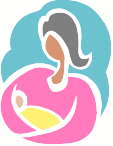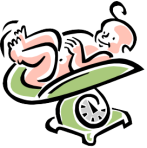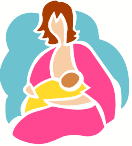 Although it’s perfectly feasible to feed your baby any way that feels comfortable, four positions are commonly recommended. These are the cradle hold, the football hold, lying on your side, and the cross-cradle hold. This last position requires you to sit up with a straight back, hold your baby sideways on, and carefully position him with his nose opposite your nipple so he has a large mouthful of breast when he latches on. It can seem like quite a complicated process for a beginner, particularly when a crying baby is added to the equation. Nevertheless, it is particularly recommended to new mothers, as it is apparently the best position in which to ensure your baby is latching on correctly – something that many women (and babies) can find quite difficult.
Although it’s perfectly feasible to feed your baby any way that feels comfortable, four positions are commonly recommended. These are the cradle hold, the football hold, lying on your side, and the cross-cradle hold. This last position requires you to sit up with a straight back, hold your baby sideways on, and carefully position him with his nose opposite your nipple so he has a large mouthful of breast when he latches on. It can seem like quite a complicated process for a beginner, particularly when a crying baby is added to the equation. Nevertheless, it is particularly recommended to new mothers, as it is apparently the best position in which to ensure your baby is latching on correctly – something that many women (and babies) can find quite difficult.
Despite the strong recommendation of these feeding positions, there appears to be virtually no scientific evidence to justify their use. In practical terms, it is easy to see why being able to discreetly breastfeed whilst sitting up is a useful skill to master, but for a new mother, simply being able to comfortably nourish her baby may be a more immediate priority.
A recent study conducted at hospitals in the UK and France calls into question the idea that the traditionally recommended feeding positions are automatically the best ones1. During the study, 40 women whose babies were less than a month old were videotaped breastfeeding in a series of recording sessions. As long as feeding was going well, mothers were not advised or guided in any way: they were simply left to get on with it in whichever was most comfortable for them. In the ‘best’ recorded feeding session 21 of the mothers sat upright to feed their babies, one lay flat on her back, and one lay on her side; the remaining 17 were semi-reclined with their babies lying on their tummies (a behaviour termed ‘Biological Nurturing’).
There were some striking differences in the feeding process when mothers adopted a reclining position, as opposed to sitting upright. When babies lay on their mothers’ tummies, their mothers’ hands were free to gently guide them. Stroking their babies’ feet seemed to be particularly helpful, as it released mouth and tongue reflexes that helped them to latch on. By contrast, when babies were held in their mothers’ arms, their legs and feet were left in thin air, and the foot-to-mouth connection was lost.
The reclinining group did not need to line up the nose and nipple, and make sure the baby’s mouth was open wide enough before initiating the latch: as the baby was on top, gravity pulled his tongue and chin forward, allowing him to attach himself, even when he was sleepy. Gravity also automatically ensured a close fit between the baby’s chin and the mother’s breast, facilitating deep suckling and producing the ear and jaw movements that indicate successful feeding.
Perhaps the most interesting result, however, was that babies exhibited reflexes that helped feeding when their mothers were reclined, but hindered it when their mothers were upright. When they were lying on their mothers’ tummies, head-righting and -lifting reflexes allowed the baby to orientate himself for successful latching on. When mothers were upright however, these irregular, jerky head movements had the opposite effect: the head bobbing that resembled ‘nodding’ when a mother was reclined was perceived as ‘head butting’ when a baby was held sideways against an upright mother. The gravitational forces that had helped attachment in reclining postures dragged babies away from their mothers when they sat up. It was harder to keep the baby latched on, and mothers reacted by tightening their grip, resulting in back arching and arm and leg cycling that appeared like thrashing or flailing.
It is important to view these results in context: this was an observational, rather than a controlled study, so the data cannot ‘prove’ that one feeding method is better than another. Many of the mothers who participated fed quite happily whilst sitting upright – as do many women every day – so it’s clear that a reclining posture is not required for successful feeding.
Nevertheless, this research does call into question the idea that a position like the cross-cradle hold is the best one to recommend to new mothers. Innate early breastfeeding behaviours were observed to help attachment when a mother lay back with her baby lying on her tummy, but not when she sat up; reflexes and gravitational forces which aided latching on when a mother reclined, hindered it when she was upright. If, as this study suggests, women can just lie back and let nature take its course, the often fraught early days of breastfeeding could potentially be a much more relaxed affair.
 Prior to
Prior to  I have spoken to many mothers, including two midwives, who have used shields to ease nipple pain while they are breastfeeding without any apparent problems for their babies. Although they have been described (in the words of one mother) as ‘a godsend – the thing that made breastfeeding bearable for me,’ they are not recommended by the National Health Service.
I have spoken to many mothers, including two midwives, who have used shields to ease nipple pain while they are breastfeeding without any apparent problems for their babies. Although they have been described (in the words of one mother) as ‘a godsend – the thing that made breastfeeding bearable for me,’ they are not recommended by the National Health Service. The first couple of days at home were pretty breezy. Before I left hospital I was assured by two midwives that C was latching on properly – cheeks puffed out, chin pumping, ears wiggling – so I was confident we had the technique sorted. Family visited and I assured them everything was going well, demonstrating our successful feeding on several occasions. By the time I got to day four, however, things weren’t quite so easy. Accompanying the hormone-induced plunge into despair inadequately named ‘the baby blues’ (that coincides with the start of proper milk production) was a serious deterioration of my nipples.
The first couple of days at home were pretty breezy. Before I left hospital I was assured by two midwives that C was latching on properly – cheeks puffed out, chin pumping, ears wiggling – so I was confident we had the technique sorted. Family visited and I assured them everything was going well, demonstrating our successful feeding on several occasions. By the time I got to day four, however, things weren’t quite so easy. Accompanying the hormone-induced plunge into despair inadequately named ‘the baby blues’ (that coincides with the start of proper milk production) was a serious deterioration of my nipples.